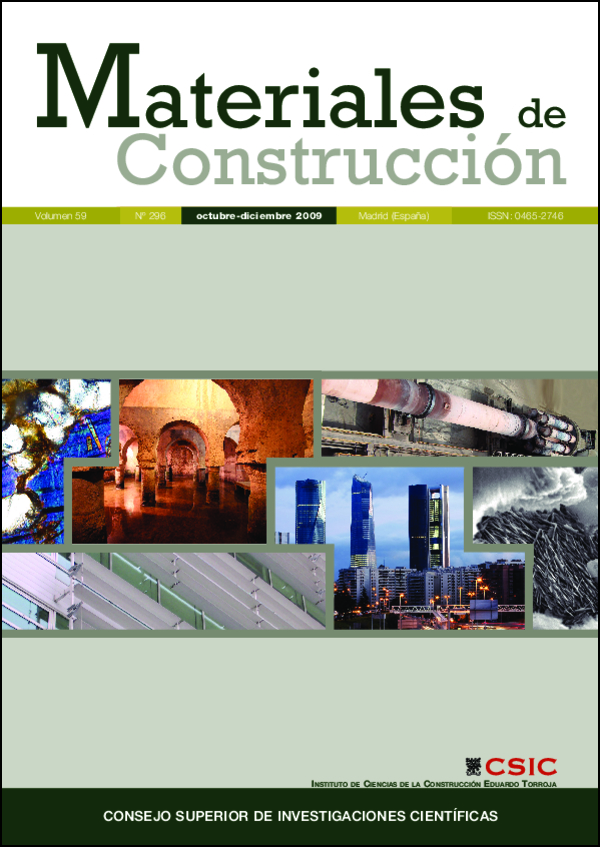Studies on the behaviour of different spent fluidized-bed catalytic cracking catalysts on Portland cement
DOI:
https://doi.org/10.3989/mc.2009.48108Keywords:
Thermal analysis, X-ray diffraction, hidration, pozzolan, compressive strengthAbstract
The fluidized-bed catalytic cracking catalyst (FCC) it is a residue from the industry of the petroleum that shows a high pozzolanic reactivity and, in cementing matrix, it significantly improves their mechanical behaviour as well as durability. In this research a comparative study on residues of catalyst from different sources has been carried out, in order to know if these residues can be used jointly in an indiscriminate way or, on the contrary, it is necessary to classify them according to their characteristics. Thus, a study on five different FCC residues, supplied from different companies, has been carried out, and their physical-chemical characteristics, pozzolanic reactivity by means of thermogravimetric analysis and the evolution of the mechanical strength of mortars were studied. After analyzing all the aspects, it can be concluded that no significant differences among the different tested catalysts were found.
Downloads
References
(1) Stroeven, P.; Bui, D.; Sabuni, E.: “Ash of vegetable waste used for economic production of low to high strength hydraulic binders”. Fuel, vol. 78, nº 2 (1999), pp. 153-159. doi:10.1016/S0016-2361(98)00143-4
(2) Sánchez de Rojas, M. I.; Frías, M.; Rivera, J.; Escorihuela, M. J.; Marín, F. P.: “Research about the pozzolanic activity of waste materials from calcined clay”. Mater. Construcc., vol. 51, nº 261 (2001), pp. 45-52.
(3) Goñi, S.; Guerrero, A.; Macias, M. A.; Pena, R.; Escalante, E. F.: “Secondary raw materials for synthesising new kind of cement”. Mater. Construcc., vol. 51, nº 263-264 (2001), pp. 71-84.
(4) Gutiérrez, P. A.; Fernández Cánovas, M.: “Efficiency coefficient of silica fume”. Mater. Construcc., vol. 49, nº 253 (1999), pp. 57-63.
(5) Gutiérrez, R. M. de; Delvasto, S.; Talero Morales, R.: “A new pozzolan for high performance cementitious material”. Mater. Construcc., vol. 50, nº 260 (2000), pp. 5-13.
(6) Frías, M.; Sánchez de Rojas, M. I.: “Influence of the metakaolin on porous structure of matrixes based in mk/cement”. Mater. Construcc., vol. 50, nº 259 (2000), pp. 57-67.
(7) Douglas, M.; Considine, P. E.: Tecnología del petróleo, Publicaciones Marcombo, 1977.
(8) Meyers, R. A.: Handbook of petroleum refining processes, Mc. Graw-Hill, 1996.
(9) Escardino, A.; Amorós, J. L.; Moreno, A.; Sánchez, E.: “Utilizing the used catalyst from refinery FCC units as a substitute for kaolin in formulating ceramic frits”. Waste Management and Research, vol. 3, (1995), pp. 569-578.
(10) Payá, J.; Monzó, J.; Borrachero, M. V.: “Fluid catalytic cracking catalyst residue (FC3R). An excellent mineral by-product for improving early strength development of cement mixtures”. Cem. Concr. Res., vol. 29 (1999), pp. 1773-1779. doi:10.1016/S0008-8846(99)00164-7
(11) Payá, J.; Monzó, J.; Borrachero, M. V.; Velázquez, S.; Soriano, L.: “Study on the properties of different spent silicoaluminous catalysts and their use in cementing mixtures”. 8th CANMET, Las Vegas (2004), Supplementary papers, pp. 513-527.
(12) Payá, J.; Monzó, J.; Borrachero, M. V.; Velázquez, S.: “The chemical activation of pozzolanic reaction of fluid catalytic cracking catalyst residue (FC3R) in lime pastes”. Advances in Cement Research, vol. 19, nº 1 (2007), pp. 9-16. doi:10.1680/adcr.2007.19.1.9
(13) Wan-Lung Wu; Jung-Hsiu Wu; Kung-Chung Hsu: “Subproductos del fraccionamiento catalítico del petróleo: características, actividad puzolánica y su efecto en las propiedades del mortero”. Cemento y Hormigón, nº 850 (2003), pp. 18-25.
(14) Pacewska, B.; Wilinska, I.; Bukowska, M.; Blonkowski, G.; Nocun-Wczelik, W.: “An attempt to improve the pozzolanic activity of waste aluminosilicate catalyst”. Journal of Thermal Analysis and Calorimetry, vol. 77 (2004), pp. 133-142. doi:10.1023/B:JTAN.0000033196.30760.af
(15) García de Lomas, M.; Sánchez de Rojas, M. I.; Frías, M.: “Pozzolanic reaction of a spent fluid catalytic cracking catalyst in FCCcement mortars”. Journal of Thermal Analysis and Calorimetry, vol. 90, nº 2 (2007), pp.443-447. doi:10.1007/s10973-006-7921-7
(16) García de Lomas, M.; Sánchez de Rojas, M. I.; Frías, M.: Comportamiento científico-técnico de los cementos Portland elaborados con catalizador FCC, Monografía Instituto de Ciencias de la Construcción Eduardo Torroja, nº 412, 2006.
(17) UNE-EN 196-1. “Métodos de ensayo de cementos. Parte I: Determinación de resistencias mecánicas”. 1996.
(18) Vázquez, T.: Estudio de algunos componentes del cemento por espectroscopia infrarroja. Monografía Instituto de Ciencias de la Construcción Eduardo Torroja, nº 297, 1971.
(19) Luxán, M. P.; Vázquez, T.: “The silica gel as a Standard pozzolan: its hard activity and its limitations”. Il cemento, vol. 3 (1974), pp. 113-130.
(20) Pacewska, B.; Wilinska, I.; Bukowska, M.: “Hydration of Cement slurry in the Presence of Spent Cracking Catalyst”. Journal of Thermal Analysis and Calorimetry, vol. 60 (2000), pp. 71-78. doi:10.1023/A:1010120518062
(21) Payá, J.; Monzó, J.; Borrachero, M. V.; Velázquez, S.: “Evaluation of the pozzolanic activity of fluid catalytic cracking catalyst residue (FC3R). Thermogravimetric analysis studies on FC3R-Portland cement pastes”. Cem. Concr. Res., vol. 33 (2003), pp. 603-609. doi:10.1016/S0008-8846(02)01026-8
(22) UNE 83451:1986 EX. “Adiciones al hormigón. Cenizas volantes. Determinación del índice de actividad resistente con cemento Portland”. 1986.
Downloads
Published
How to Cite
Issue
Section
License
Copyright (c) 2009 Consejo Superior de Investigaciones Científicas (CSIC)

This work is licensed under a Creative Commons Attribution 4.0 International License.
© CSIC. Manuscripts published in both the print and online versions of this journal are the property of the Consejo Superior de Investigaciones Científicas, and quoting this source is a requirement for any partial or full reproduction.
All contents of this electronic edition, except where otherwise noted, are distributed under a Creative Commons Attribution 4.0 International (CC BY 4.0) licence. You may read the basic information and the legal text of the licence. The indication of the CC BY 4.0 licence must be expressly stated in this way when necessary.
Self-archiving in repositories, personal webpages or similar, of any version other than the final version of the work produced by the publisher, is not allowed.
















